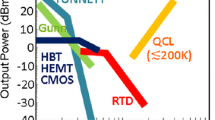Contents
The power capabilities of three different two-terminal devices, GaAs IMPATT diodes, InP Gunn devices and GaAs TUNNETT diodes are evaluated. Two different selective etching technologies have been employed to fabricate devices on either a diamond heat sink or an integral heat sink. The reported RF power levels in fundamental mode are 20 mW at 120 GHz and 15 mW at 135 GHz for D-band GaAs IMPATT diodes, 21 mW at 120 GHz, 17 mW at 133 GHz and 8 mW at 155 GHz for D-band InP Gunn devices and up to 35 mW around 103 GHz for W-band GaAs TUNNETT diodes. Typical de to RF conversion efficiencies range from 0.9% up to over 4.0%. In second harmonic mode power levels of 0.25 mW at 223 GHz were measured from TUNNETT diodes and 0.4 mW at 220 GHz from a Gunn device.
Übersicht
Die Leistungsfähigkeit dreier verschiedener Zweipolbauelemente, GaAs-IMPATT-Dioden, InP-Gunn-Bauelemente und GaAs-TUNNETT-Dioden, wird untersucht. Zwei unterschiedliche Herstellungsverfahren mit selektivem Ätzen wurden eingesetzt, um Bauelemente auf einer Diamant- bzw. integrierten Wärmesenke herzustellen. Hochfrequenzausgangsleistungen von 20 mW bei 120 GHz und 15 mW bei 135 GHz wurden mit GaAs-IMPATT-Dioden für das D-Band erzielt, 21 mW bei 120 GHz, 17 mW bei 133 GHz und 8 mW bei 155 GHz mit InP-Gunn-Bauelementen für das D-Band und bis zu 35 mW um 103 GHz mit GaAs-TUNNETT-Dioden für das W-Band. Typische Hochfrequenzwirkungsgrade lagen zwischen 0,9% und über 4%. Bei der ersten Oberwelle wurden mit TUNNETT-Dioden HF-Leistungen von 0,25 mW bei 223 GHz gemessen und 0,4 mW bei 220 GHz mit einem Gunn-Bauelement.
Similar content being viewed by others
References
Schellenberg, J. M.; Lau, C. L.; Feng, M.; Brusenback, P.: W-band oscillator using ion-implanted InGaAs MESFET's. IEEE Microwave and Guided Wave Letters MGWL-1(5) (1991) 100–102
Kwon, Y.; Pavlidis, D.; Tutt, M.; Ng, G. I.; Lai, R.; Brock, T.: W-band monolithic oscillator using InA1As/InGaAs HEMT's. Electronics Letters 26 (18) (1990) 1425–1426
Kamoua, R.; Eisele, H.; Haddad, G. I.: D-band InP Gunn devices. To appear in Solid-State Electronics, 1993
Eisele, H.: GaAs W-band IMPATT diodes: The first step to higher frequencies. Microwave Journal 34 (1991) 275–282
Haddad, G. I.; East, J. R.; Kidner, C.: Tunnel transit-time (TUNNETT) devices for terahertz sources. Microwave and Optical Technology Letters 4 (1991) 23–29
Eisele, H.: Electron properties in GaAs for the design of mm-wave IMPATTS. International Journal of Infrared and Millimeter Waves4 (1991) 345–354
Eisele, H.; Kidner, C.; Hadded, G. I.: A CW GaAs TUNNETT diode source for 100 GHz and above. Proceedings of the 22nd European Microwave Conference, Helsinki, Finland (1992) 467–472
Eisele, H.: Selective etching technology for 94 GHz GaAs IMPATT diodes on diamond heat sinks. Solid-State Electronics 32 (1989) 253–257
Eisele, H.; Hadded, G.I.: GaAs single-drift flat-profile IMPATT diodes for CW operation in D-band. Electronics Letters 28 (1992) 2176–2177
Rolland, P. A.; Friscourt, M. R.; Lippens, D.; Dalle, C.; Nieruchalski, J. L.: Millimeter wave solid-state power sources. Proceedings of the International Workshop on Millimeter Waves, Rome, Italy (1986) 125–177
Rydberg, A.: High efficiency and output power from second- and third-harmonic millimeter-wave InP-TED oscillators at frequencies above 170 GHz. IEEE Electron Dev. Letters EDL-11 (1990) 439–441
Kidner, C.; Eisele, H.; East, J.; Haddad, G. I.: Design, fabrication and evaluation of tunnel transit-time diodes for V-band and W-band power generation. Proceedings of the 1992 IEEE MTT-S International Microwave Symposium, Albuquerque, New Mexico (1992) 1089–1092
Wandinger, L.: mm-wave InP Gunn devices: status and trends. Microwave Journal 24 (1981) 71–78
Eddison, I. G. et al.: Efficient fundamental frequency oscillation from mm-wave InP n+-n-n+ TEOs. Electronics Letters 17 (1981) 758–760
Teng, S. J. J.; Goldwasser, R. E.: High performance second-harmonic operation W-band GaAs Gunn diodes. IEEE Electron Device Letters EDL-10 (1989) 412–414
Author information
Authors and Affiliations
Rights and permissions
About this article
Cite this article
Eisele, H., Kamoua, R., Haddad, G.I. et al. Active two-terminal devices as local oscillators for low-noise receiver systems at submillimeter wave frequencies. Archiv f. Elektrotechnik 77, 15–19 (1993). https://doi.org/10.1007/BF01574916
Received:
Issue Date:
DOI: https://doi.org/10.1007/BF01574916




